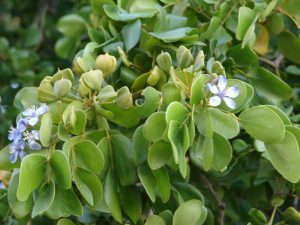For decades now, I’ve been involved with studying a small island in the Florida Keys. It sometimes amazes me how much of history can be elucidated through geography rather than linear history. For me Lignumvitae Key has been that place – it has allowed me to pull together information on what one would think are a plethora of unrelated threads. This is one of them:
Long before technology introduced titanium alloys or polymers, we had the nearly mythic wood called “lignum vitae”. One of the strongest, heaviest woods in the world, lignum vitae will sink, even in salt water. A tree with wood so dense it is almost impossible to drive a nail into doesn’t sound very useful.
Yet it was one of the most valuable exports in the world, from as early as the beginning of the 16th century up until the mid 1900’s. In Florida, Lignumvitae Key has an abundance of its namesake tree; a Spanish chart created in 1760 names the key as Cayo de la Leña, which translates roughly to “timber” or “firewood” in English. Lignum vitae is the national tree of the Bahamas, and its flowers are the Jamaican national flower. Why has this wood been so highly valued for so long?
 It resists the rot caused by moisture and pests with such efficacy, that the only discovered remains of 800 year-old dwellings built by the Taino Indians in the Virgin Islands were the posts made of lignum vitae.
It resists the rot caused by moisture and pests with such efficacy, that the only discovered remains of 800 year-old dwellings built by the Taino Indians in the Virgin Islands were the posts made of lignum vitae.
Why is the wood so resilient? Lignumvitae tree resin contains natural oils which are exuded when the wood is abraded. As a result, if if Lignumvitae wood is used used in a situation where today we think of metal ball bearings that need to be lubricated, it turns out to be a maintenance free material, as Lignuvitae is essentially self lubricating. This makes the wood extremely useful for specialized commercial-grade equipment and parts. Hydroelectric plants going back to the 1920’s have used bearings for turbines made out of lignum vitae, and, building on many centuries of maritime experience, even the world’s first nuclear-powered submarine, the USS Nautilus, has shaft strut bearings made out of lignumvitae wood.
Its ability to withstand pressure, stress, water, and high temperature has seen uses as varied as ship propellers, gears in pendulum clocks and chronometers, mallets, and even as a jeweler’s lap for polishing gemstones. The United Railroads of San Francisco used lignum vitae to insulate the feeder wires for the city’s trolley system at the turn of the century, and many of the those insulators remained intact even through the 1906 earthquake and the subsequent fires that burned hot enough to soften iron poles and melt copper cables.
The name lignum vitae (Latin for “tree of life” or “wood of life”) actually refers to the wood of either of two related trees: Guaiacum officinale and Guaiacum sanctum. Both of these trees have the hard wood and resin properties characteristic of lignum vitae, and all species of Guaiacum are potentially endangered.
Though the trees are hardy, and have been estimated to live for up to 1,000 years, they grow very slowly. Where they are not over-exploited for trade and commercial use, they grow plentifully in the wider Caribbean region. However, habitat loss from encroaching human population, coupled with heavy harvesting for the valuable wood and resin, make it difficult for lignumvitae to recover from exploitation, as its slow growth rate dramatically prolongs the progress of regeneration.
Next time: The trees’ most interesting use of all, and its tie to world history.

